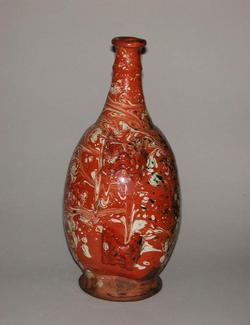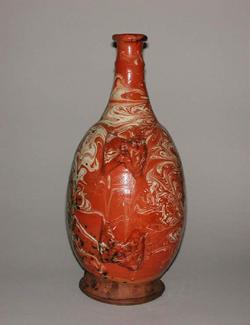Current Location: Gallery 27 (Glaisher)
Maker(s)
Pottery:
Unidentified Tuscan pottery
Entities
Categories
Description
Pale brownish-red earthenware, coated with brownish-red slip, marbled in white slip, apart from a short distance above the foot, and spattered on one side in green under clear lead glaze. Oviform body with outward curving foot, slender tapering neck with a flanged mouth, and on either side of the body two loops for straps, each moulded in the form of a lion's mask
Notes
History note: Dug up in the dunes at Hillegom, South Holland, in 1808. Sotheby's, 3 March 1898, lot 622; bought for £4.14.0 on behalf of Dr J.W. L. Glaisher, FRS, Trinity College, Cambridge
Legal notes
Dr J.W.L. Glaisher Bequest
Measurements and weight
Height: 33 cm
Width: 20.5 cm
Acquisition and important dates
Method of acquisition: Bequeathed
(1928-12-07)
by
Glaisher, J. W. L., Dr
Dating
16th Century
Circa
1600
CE
-
1650
CE
Note
In the nineteenth century when Dr J.W.L. Glaisher bought this example, marbled pilgrim flasks or costrels were thought to be of English origin. The find place of this one, which was dug up in the dunes at Hillegom, near Leiden in the Netherlands in 1808, raised doubts about that attribution. They are now known to have come from the Lower Arno Valley area of Tuscany, possibly from Pisa, Pontorme, or Montelupo. Archaeological evidence for slipware production, including kiln-wasters of marbled flasks, has been found in the village of Pontorme situated between Empoli and Montelupo, but it is not possible to attribute this example to a specific production place. Slipware and maiolica from Tuscany was shipped to the Netherlands and England from Pisa during the sixteenth and seventeenth centuries. This is an exceptionally large and fine example, in excellent condition. A flask of the same type, but rather more bulbous, appears in paintings executed in the mid seventeenth century by the Dutch artist, Gerrit Dou (1613-75), indicating that they were made before 1650. (See Documentation, Timothy Wilosn's article in ed. Siena, Silvia Lusuardi, 2023), The Fitzwilliam has another smaller flask, GL.C.28-1928 which was found in London. Further examples of marbled slipware flasks are in the British Museum, and the Ashmolean Museum (see Documentation).
School or Style
Renaissance
Components of the work
Decoration
composed of
slip
( pale brownish-red and cream)
copper
( probably, spattering of green spots)
Most Of Visible
composed of
lead-glaze
Foot
Diameter 12 cm
Body
Loops
Most Of Surface
Materials used in production
pale brownish-red
Earthenware
Inscription or legends present
- Text: Te Hillegorm by het afzanden der duinen/ qwonden. Anno, 1808
- Location: Unknown
- Method of creation: Hand -written
- Type: Label
References and bibliographic entries
Identification numbers
Accession number: C.1850-1928
Primary reference Number: 72753
Old object number: 812
Stable URI
Audit data
Created: Saturday 6 August 2011
Updated: Tuesday 30 April 2024
Last processed: Tuesday 2 September 2025
Associated departments & institutions
Owner or interested party:
The Fitzwilliam Museum
Associated department:
Applied Arts







